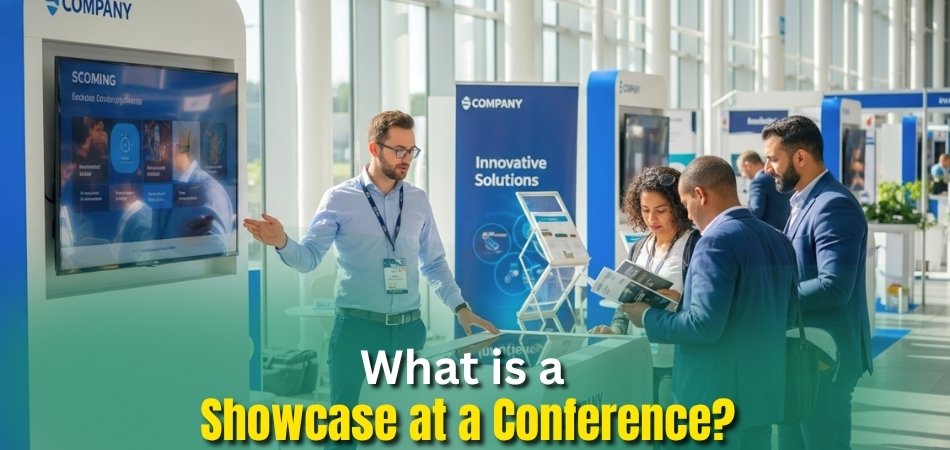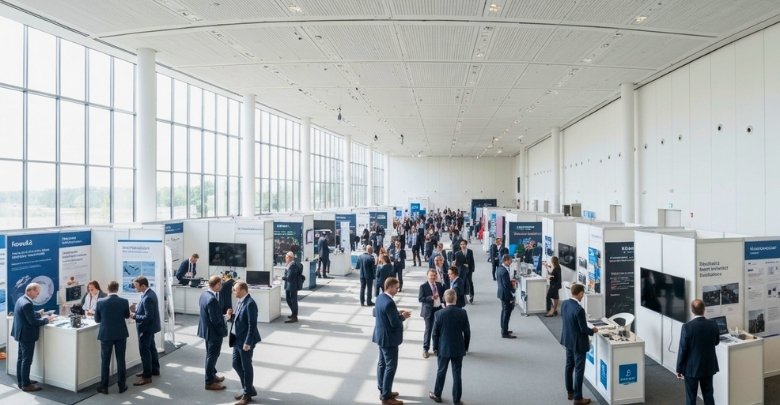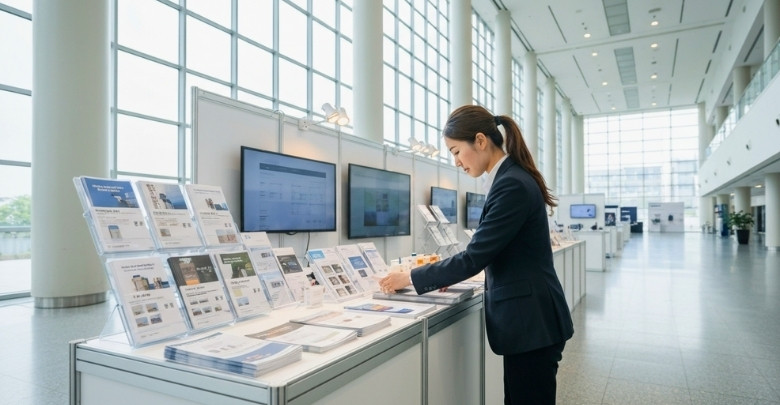Showcasing at a conference is a great way for people to share their work. It’s an active display, letting you see things up close. This makes it interactive and fun for attendees. Many ask what is a showcase at a conference.
A showcase at a conference is an interactive session where participants display their work, products, or research through live demos and creative setups. It encourages networking, learning, and collaboration while helping presenters gain visibility and share ideas in an open, engaging environment.
We know you’re curious about these event features. You want a clear picture of what they offer. Read on to explore all the details about this exciting part of conferences.
What is a Showcase at a Conference?
At a conference, a showcase is a special event that stands out. It lets people share their work, ideas, or products in a fun and hands-on way. Many prefer this over long presentations since it feels more open and friendly. Keep reading to know how a showcase works and why it matters.

Interactive Presentation
A showcase gives people a chance to show what they do in action. They can give live demos, display models, or show creative setups. It is less formal and more fun than a stage talk. This setup helps visitors see and understand the work directly.
Networking and Engagement
These sessions help people meet others with similar interests. Presenters can talk freely with visitors and share ideas. This helps build strong professional connections. It is common in global events like conferences in USA, Canada, or other countries, where meeting experts adds great value.
Visibility for Projects and Products
Presenters can use showcases to get attention for their work. It helps them share research, new apps, art, or business ideas. Many visitors include publishers, investors, or future partners. The open setup allows everyone to learn more about what others do.
Flexible Formats
Every showcase looks a little different. Some use posters, others use screens or booths. Some even bring props or creative displays to draw attention. This flexible setup makes each booth or demo feel unique and interesting.
Business and Commercial Growth
A showcase can also open business doors. Developers can find investors for new software or products. Artists may connect with buyers or gallery owners. Companies use it to show new ideas and make deals right on the spot.
Meaningful Opportunities
It is not just about showing work but sharing stories behind it. People can explain what inspired them and how they built their project. This helps others connect on a deeper level. It makes the event more personal and memorable.
Encourages Learning
Showcases are great for learning new things quickly. Visitors can ask questions, test tools, and see how ideas work in real life. This kind of learning feels more natural than listening to a long lecture. Everyone leaves with something new to think about.
Builds Community
A well-planned showcase brings people together. It helps both beginners and experts talk, share, and support each other. This sense of community keeps people coming back to future conferences. It also helps new ideas grow and spread faster.
Showcases add life and excitement to any conference. They turn simple displays into hands-on learning spaces. People get to share what they love and find others who care too. If you ever attend one, take time to explore and connect—you’ll gain much more than you expect.
How a Conference Showcase Differs from Regular Presentations?
During a presentation, the main focus is on listening and observing as the speaker shares ideas, research, or findings using slides or notes. It’s a structured way to learn through spoken words and visuals. A showcase, on the other hand, is more interactive and lively; participants can see, touch, and experience what’s being shared. Read below to explore how they differ and why that matters.
| Feature | Conference Showcase | Regular Presentation |
| Main Focus | Shows real products, services, or prototypes in action | Shares ideas, research, or theories through speech or slides |
| Interaction Level | Very interactive and hands-on | Mostly one-way, with limited questions at the end |
| Format Style | Open, flexible, and casual — attendees move freely | Structured and time-bound with a fixed agenda |
| Experience Type | Multiple short demos or displays | One main talk or panel discussion |
| Visual Elements | Heavy use of visuals, screens, and real objects | Usually, slides or charts are on a screen |
| Visitor Engagement | Two-way talk — exhibitors adjust based on interest | Mostly one-way presenter delivers content |
| Purpose | To show proof of concept or live performance | To explain ideas, share knowledge, or present findings |
Level of Interaction
A regular talk usually keeps the audience listening until the end. In a showcase, people get involved right away. You can ask questions, join small demos, and see things work in real time. Unlike a regular presentation that focuses on sharing ideas or research, a showcase often involves an exhibitor at a conference who demonstrates a product, service, or innovation directly to attendees.
Focus of the Event
The heart of a presentation is the message or theory being shared. The main goal is to teach or explain something clearly. A showcase, on the other hand, is built around a product or service. The aim is to show proof of how it works, not just talk about it.
Timing and Flow
Presentations have a set time and fixed structure. The audience comes, listens, and leaves after the session ends. A showcase works differently. People move around freely, stop where they like, and spend as much time as they want watching demos or talking to the exhibitor.
Variety of Activities
Instead of one long talk, a showcase includes several small experiences. Visitors can try demos, touch displays, or explore mini sections of the booth. Each moment feels new and interesting. This setup keeps things lively and helps people learn in short, fun ways.
Use of Visuals and Real Objects
Showcases are filled with screens, models, and real items to test. Presentations depend more on slides and words. Seeing things up close helps people understand better. The mix of visuals and touch makes the showcase more exciting and easier to remember.
Both styles have their own value and purpose. Presentations help you learn and think deeply about new ideas. Showcases let you see real results and test things for yourself. Knowing the difference helps you get more from every event you attend.
Types of Showcases You Can Find at Conferences
Conferences often have special areas. These areas let people show off new things. They are called showcases. Many kinds of showcases exist. They help share ideas and products.
Product Demos and Live Shows
A company might show how its product works. This could be software features. It might be a new gadget. They show it right there to people. This helps folks see the product in action and ask questions easily. This is a very common type of conference showcase.
Startup Showcases and Pitch Booths
New small companies often set up booths. They show their fresh ideas and products. They hope to find new users for their services. These startups also look for partners or people to invest money in them. It’s a big chance for new businesses to grow.
Technology Exhibitions and Trade Show Booths
These are often larger spaces. Many products are on display together. You might see new computer parts. There could be different software systems. Other services that go with them are also shown. These bigger booths let many companies share their tech.
Innovation and Prototype Showcases
Some showcases are for brand-new ideas. They show things that are still being built. These are not full products yet. Researchers or thinkers share their early work. They get feedback and show what might come next. It’s exciting to see future items.
Creative and Design Displays
These showcases are about art and design. You might see cool visual art. There could be interactive screens. People show off new creative ideas. These displays want to make people think. They are often very engaging and fun to look at.
Poster and Interactive Presentation Mixes
Imagine a poster session, but better. It has posters, but also videos. You can touch things and try them out. There are also live talks and Q&A times. This lets people learn in many ways. It makes the information more lively and easier to grasp.
Gallery Walk and Showcase Corridors
Sometimes, many small displays are set up in a line. Visitors can walk along this path. They can stop at any display that interests them. This way, people can see many different things. It lets them pick what they want to explore more deeply.
These many kinds of showcases make conferences exciting. They let people see new ideas up close. They also help people learn new things. It is a great way to connect with creators and their work.
Who Participates in a Conference Showcase?
Many different people make a showcase happen. Each person has a special job. They all work together. This helps the showcase be a big success. Let’s look at who is involved in these events.
Exhibitors, Presenters, and Vendors
These are the people who bring their products. They might show a new invention. They set up their booth and talk to visitors. They answer questions and show how things work. Businesses and organizations often take part in showcases to reach new audiences, but they also plan their budgets carefully, keeping in mind the cost of exhibiting at a conference and the potential return on that investment.
Sponsors and Supporting Groups
Some companies help pay for the showcase. They might get special spots for their booths. They could help many small companies. Sometimes, their name is put on the showcase area. This helps the event and gives it good visibility.
Conference Organizers and Planners
These people decide where everything goes. They pick who can show their items. They plan the booth layout and times. They also tell everyone about the showcase area. They make sure the whole event runs smoothly for all involved.
Attendees and Visitors
These are the people who come to the conference. They are customers, users, or possible partners. They come to look, ask questions, and try new things. They also give helpful ideas back to the presenters. Their input is very important.
Support Staff and Tech Crews
This team makes sure the power works. They check the internet connection. They help with lights and display setups. They also help presenters set up and take down their booths. They are key to making sure everything runs without problems.
Judges and Reviewers
Sometimes, there are special competitions. Judges look at the showcases. They might give out awards. They could pick winners for new funding. This happens a lot in innovation or startup events. They help find the best new ideas.
Everyone involved helps the showcase shine. From the people showing off their work to the guests, it’s a team effort. This creates a lively place for new ideas. It helps many people learn and connect.
Tips to Prepare for a Conference Showcase
Getting ready for a showcase takes some thought. With good planning, your display will stand out. These tips will help you make a great impression. A well-planned booth can bring good results.
- Set Clear Goals. Think about what you want. Do you need new sales leads? Do you want feedback? Your main goal will guide all your choices.
- Know Your Audience. Find out who will visit. What do they care about most? Also, think about how people walk around the show area.
- Design Your Booth Well. Use your company’s colors and logo clearly. Make sure people can easily walk into your space. Plan where demos will happen.
- Prepare Visuals. Have big banners and posters. Use digital screens for videos or slides. Make easy-to-read charts. You can also use QR codes for people to scan info.
- Have Reliable Demos. Test your products many times. Plan exactly what you will say and show. Always have backup devices and spare parts ready.
- Train Your Team. Teach everyone how to greet people. Practice answering common questions. Make sure they know how to do the demos.
- Market Beforehand. Let people know you will be there. Send emails and post on social media. Tell your important contacts your booth number.
- Handle Logistics. Plan how your items will get there. Check if you have power and internet. Make a list of everything you need to set up.
- Engage Visitors. Use fun games or small quizzes. Give away small items with your brand on them. Hold short demo times that people can attend.
- Follow Up and Check Results. Collect contact details from visitors. Send emails or call them quickly after the event. See how many new leads you got.
Following these steps can make your showcase a success. Good preparation helps you meet your goals. It helps you connect with many people. Take time to plan well for the best results.
FAQs About What Is a Showcase at a Conference?
It’s normal to have more questions about these engaging conference features. We’ve gathered some common queries people ask about showcases to help you understand them even better. Here are answers to a few more important points that weren’t fully covered earlier, to give you a complete picture.
What is the Proper Etiquette for Attendees When Visiting Exhibit Booths?
When visiting a booth, always be polite and wait for your turn if it’s busy. Make eye contact with the exhibitor when they greet you. If you pick up an item, handle it carefully. Remember to be mindful of others around you and don’t block pathways.
How Do Virtual or Hybrid Conferences Integrate Showcase Elements?
Virtual showcases often use online platforms with virtual booths where presenters share videos, digital documents, and live chat. Hybrid events combine this with physical booths, allowing attendees to choose how they interact. They might offer virtual tours of physical booths or live-streamed demos. The key is to provide flexible access, no matter where attendees are joining from.
What Are Some Common Challenges Exhibitors Encounter During a Conference Display?
Exhibitors often face challenges like technical glitches with equipment or internet issues. Sometimes, it’s hard to attract enough visitors to their specific booth in a crowded hall. Keeping energy levels high throughout long event days can also be tough. Another common issue is managing unexpected questions or a sudden rush of interested attendees all at once.
How Can Attendees Maximize Their Learning Experience at a Showcase?
To maximize learning, set clear goals beforehand about what you want to discover. Don’t be shy; ask questions and engage directly with presenters. Take notes on interesting ideas or products and collect contact details for follow-up. Also, make sure to explore different booths to get a wide range of insights.
Is There a Specific Schedule or Flow for How Showcases Operate Throughout a Conference?
Showcases typically run during the main exhibition hours of a conference, often for several hours each day. Unlike fixed presentations, attendees usually move freely between booths at their own pace. Some showcases might have scheduled mini-demos or short talks at their booths, so checking the conference program is helpful. Generally, the flow is flexible, allowing for spontaneous exploration.
What Kind of Follow-up Actions Should Attendees Take After Engaging With an Exhibitor?
After talking to an exhibitor, send a personalized email expressing thanks and mentioning what you discussed. Connect with them on professional platforms like LinkedIn. Review any materials you collected and think about how their product or service could help you. If you have further questions or interest, don’t hesitate to reach out again.
Do Conference Showcases Offer Opportunities for Collaboration Between Different Exhibitors?
Yes, showcases can definitely spark collaboration between different exhibitors. Companies with complementary products or services often find each other at these events. They might discuss joint projects, partnerships, or even co-marketing efforts. Many exhibitors use these events not just to meet customers but also to connect with potential industry partners.
What Happens to the Display Materials and Products After the Event Concludes?
After the conference ends, exhibitors typically pack up their display materials, products, and equipment. Depending on their setup, some items might be shipped back to their office or stored locally. Larger displays or rental equipment are often disassembled and returned to the rental company. Careful planning for take-down and transport is crucial to ensure everything returns safely.
How Far in Advance Should an Exhibitor Begin Planning for a Conference Showcase?
Exhibitors should ideally start planning for a conference showcase at least 3 to 6 months in advance. This allows ample time to book booth space, design and order display materials, and develop compelling demos. Early planning also helps with marketing efforts to promote your presence and coordinate team schedules. For larger or more complex setups, even longer lead times might be necessary.
What Kind of Resources or Support Are Available to First-time Exhibitors?
First-time exhibitors can often find great support from conference organizers who might offer special guides or workshops. Many event venues also have dedicated exhibitor services teams to assist with setup, power, and internet. Industry associations sometimes provide mentorship programs or resources for new participants. Don’t hesitate to ask questions and seek advice from experienced colleagues or organizers.
Last Words
So, in short, a conference showcase is a dynamic, interactive event section. It allows presenters to demonstrate their work directly and engage with attendees. It creates a vibrant space for learning, networking, and opportunities for everyone involved, explaining what is a showcase at a conference.
Remember to plan well, engage openly, and follow up after the event to get the most out of it. Whether you’re presenting or visiting, these tips will help you make great connections and learn much. We wish you the best in your next conference experience!







